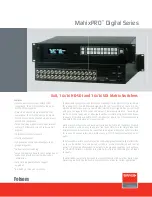
•
Area ID
: a number or IP address assigned when creating the area. You can represent the area ID as
a number from 0 to 65536 if you assign a dotted decimal format rather than an IP address.
Configuring Passive-Interface
To suppress the interface’s participation on an OSPFv3 interface, use the following command.
This command stops the router from sending updates on that interface.
• Specify whether some or all some of the interfaces are passive.
CONF-IPV6-ROUTER-OSPF mode
passive-interface {
interface-type
}
Interface
: identifies the specific interface that is passive.
• For a 10-Gigabit Ethernet interface, enter the keyword
TenGigabitEthernet
then the slot/port[/
subport] information.
• For a 40-Gigabit Ethernet interface, enter the keyword
fortyGigE
then the slot/port information.
• For a port channel interface, enter the keywords
port-channel
then a number.
• For a VLAN interface, enter the keyword
vlan
then a number from 1 to 4094.
To enable both receiving and sending routing updates, use the
no passive-interface interface
command.
To indicate that hello packets are not transmitted on that interface, when you configure a passive interface,
the
show ipv6 ospf interface
command adds the words
passive interface
.
Redistributing Routes
You can add routes from other routing instances or protocols to the OSPFv3 process.
With the
redistribute
command, you can include RIP, static, or directly connected routes in the OSPF
process. Route redistribution is also supported between OSPF Routing process IDs.
To add redistributing routes, use the following command.
• Specify which routes are redistributed into the OSPF process.
CONF-IPV6-ROUTER-OSPF mode
redistribute {bgp | connected | static} [metric
metric-value
| metric-type
type-
value
] [route-map
map-name
] [tag
tag-value
]
Configure the following required and optional parameters:
•
bgp | connected | static
: enter one of the keywords to redistribute those routes.
•
metric
metric-value
: The range is from 0 to 4294967295.
•
metric-type
metric-type
: enter
1
for OSPFv3 external route type 1 OR
2
for OSPFv3 external
route type 2.
•
route-map
map-name
: enter a name of a configured route map.
•
tag
tag-value
: The range is from 0 to 4294967295.
Open Shortest Path First (OSPFv2 and OSPFv3)
754
Summary of Contents for S4048T
Page 1: ...Dell Configuration Guide for the S4048T ON System 9 10 0 1 ...
Page 98: ... saveenv 7 Reload the system uBoot mode reset Management 98 ...
Page 113: ...Total CFM Pkts 10303 CCM Pkts 0 LBM Pkts 0 LTM Pkts 3 LBR Pkts 0 LTR Pkts 0 802 1ag 113 ...
Page 411: ...mode transit no disable Force10 Resilient Ring Protocol FRRP 411 ...
Page 590: ...Figure 67 Inspecting the LAG Configuration Link Aggregation Control Protocol LACP 590 ...
Page 646: ...Figure 87 Configuring Interfaces for MSDP Multicast Source Discovery Protocol MSDP 646 ...
Page 647: ...Figure 88 Configuring OSPF and BGP for MSDP Multicast Source Discovery Protocol MSDP 647 ...
Page 653: ...Figure 91 MSDP Default Peer Scenario 2 Multicast Source Discovery Protocol MSDP 653 ...
Page 654: ...Figure 92 MSDP Default Peer Scenario 3 Multicast Source Discovery Protocol MSDP 654 ...
Page 955: ...Figure 119 Single and Double Tag First byte TPID Match Service Provider Bridging 955 ...
















































